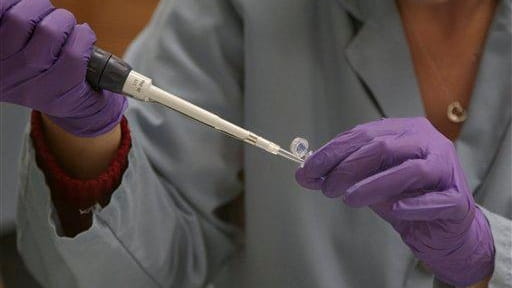LI scientists: New DNA secrets revealed

Scientists at Cold Spring Harbor Laboratory and elsewhere have found that many of the secrets within DNA -- the master molecule of life -- are likely to undergo a radical overhaul that could better explain the mystery of human development and many human diseases. (Feb. 17, 2012) Credit: AP
Scientists at Cold Spring Harbor Laboratory and elsewhere have found that many of the secrets within DNA -- the master molecule of life -- are likely to undergo a radical overhaul that could better explain the mystery of human development and many human diseases.
Chief among their findings is that so-called junk DNA -- the dark matter of the human genome -- is not junk after all because it contains an estimated 4 million "gene switches" that help govern how cells function in health and disease, scientists said.
Cold Spring Harbor Laboratory is one of the leading institutions in a paradigm shifting federal project -- known as ENCODE -- that involved 440 researchers in 32 laboratories worldwide.
The labs were tasked with finding a piece in the vast human genetic puzzle to help explain how the human genome does its job.
The investigation, which started in 2003, grew out the Human Genome Project. It ended in 2001 with the conclusion that only 1 percent to 2 percent of the human genome was functional and that the rest of the DNA was so-called dark matter -- junk.
Many scientists were skeptical at the end of the genome project when the vast majority of human DNA was written off, said Elise Feingold, program director for ENCODE.
"It just didn't seem plausible that so much of the genome was junk," Feingold said.
What scientists have now found, Feingold said, is that hidden within the lengths and stretches of life's master molecule -- and the parts that were once written off -- is the likely answer to many puzzling human disorders.
The new findings now set the stage to explain the mysteries underlying human diseases -- such as how cancer forms and proliferates. The discoveries also can help further explain why some populations never grow tall while others reach lofty heights.
Key among the findings Wednesday were those reported in the journal Nature by researchers at Cold Spring Harbor Laboratory.
They explored the very nature of the human gene, long believed to be the basic unit of heredity. Their discovery, however, turns a generations-old concept on its head.
"It will change textbooks," said Thomas Gingeras, a professor at Cold Spring Harbor Lab and lead investigator.
For generations it has been believed that a gene is a single stretch of DNA that can lead to the production of only a single protein.
But DNA isn't just a spiraling helix, Gingeras explained; it's a dynamic molecule that folds into a tight wad that puts into proximity active, protein-producing regions with those that possess regulatory functions, he said.
Scientists now understand that any given region in the genome "is like a roof that has overlaying shingles," he said. "One region can be coding and one can have non-coding and regulatory functions at the same time."
In short, the same genetic sequences can be being used for very different functions, he said.
Gingeras and his team also discovered a new class of RNA -- ribonucleic acid -- molecules. These molecules, he said, act like components in a biologic switchboard, overseeing a vast network of events in the cell, regulating processes of DNA replication.
"Looking at the evolution of the definition of a gene that began in middle of the 19th century, the ENCODE research results published Thursday open up an entirely new universe to explore that I'm sure will have an impact on the way we understand the genetics of diseases," said Dr. Bruce Stillman, president of Cold Spring Harbor Laboratory.
